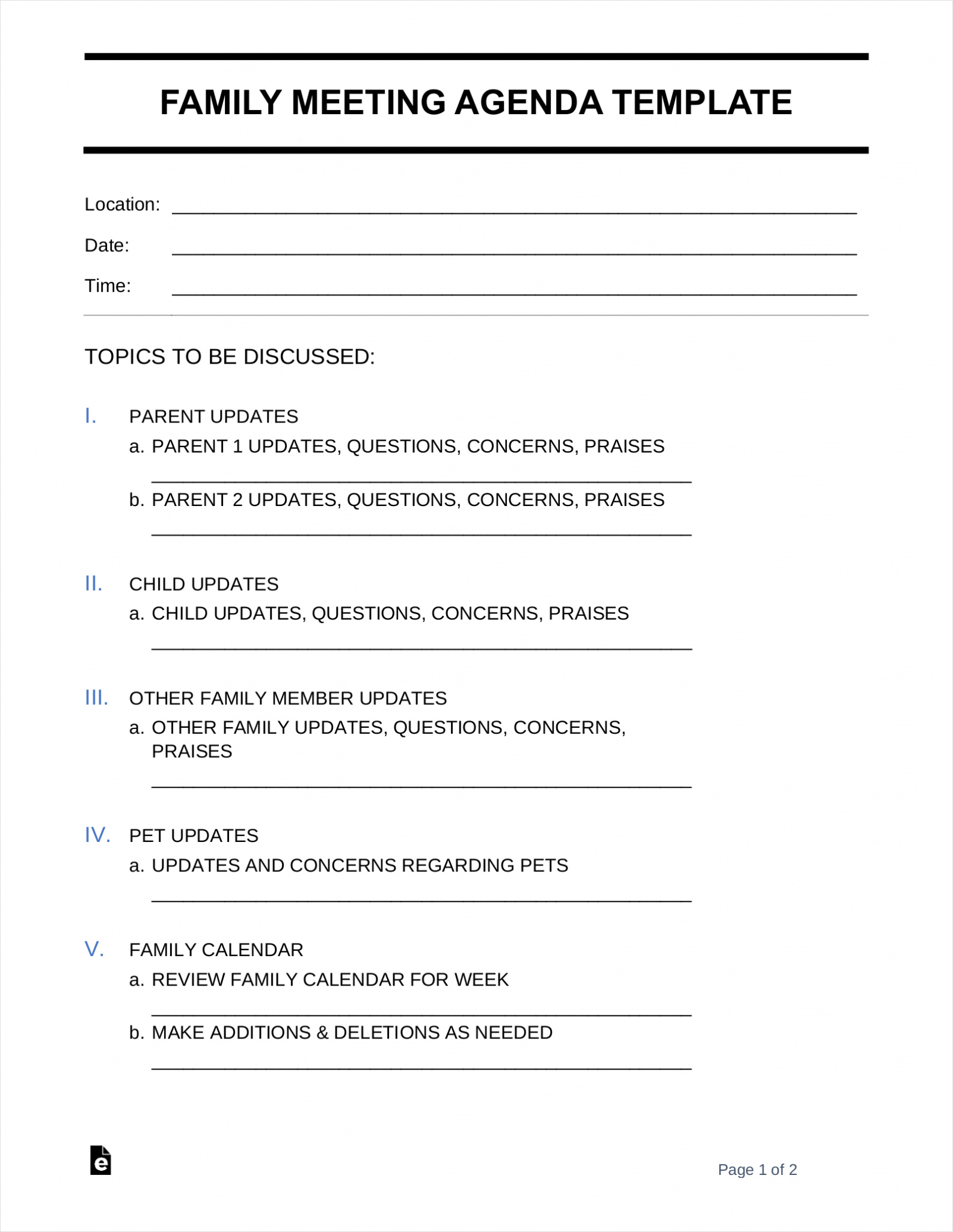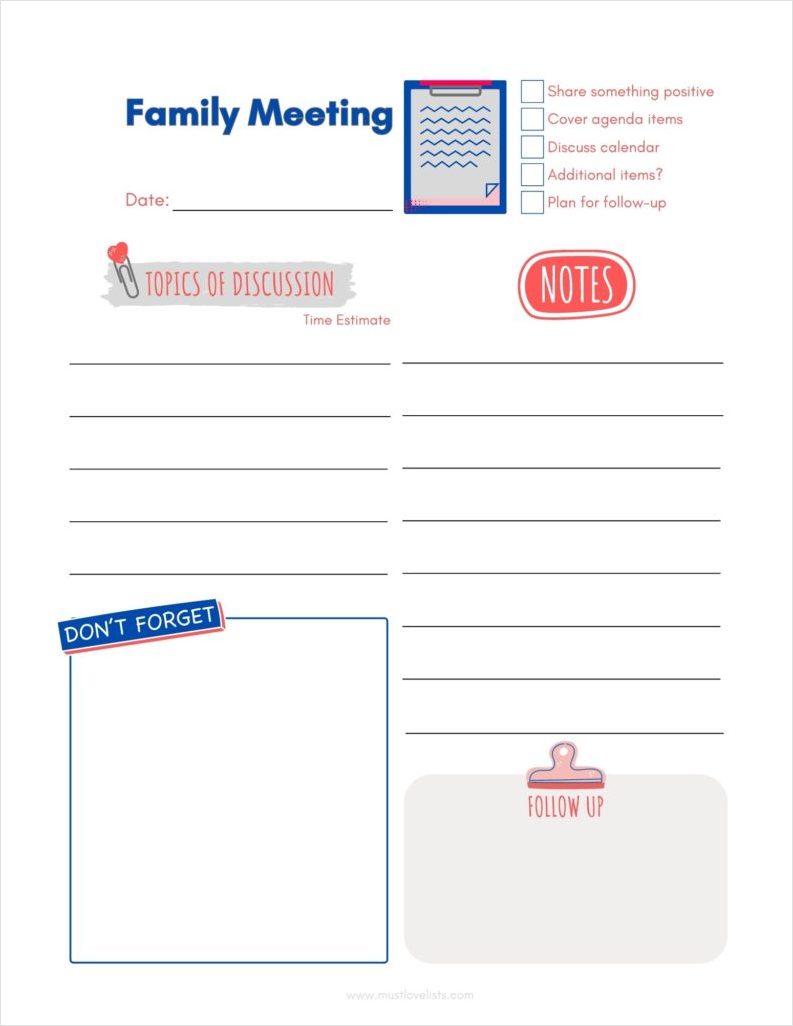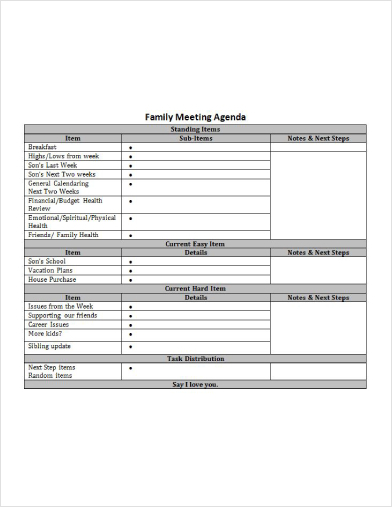A family meeting agenda is a structured plan that outlines the topics to be discussed and the goals to be achieved during a family meeting. It serves as a roadmap for the meeting, ensuring that all important matters are addressed and everyone has a chance to share their thoughts and concerns. A well-planned agenda can help to keep the meeting focused, productive, and efficient.
Why Should You Have a Family Meeting Agenda?
Having a family meeting agenda is essential for several reasons:
- Organization: An agenda helps to keep the meeting organized and prevents it from veering off-topic.
- Efficiency: With a clear agenda, everyone knows what to expect, allowing the meeting to run smoothly and efficiently.
- Equal Participation: An agenda ensures that all family members have an opportunity to contribute and be heard.
- Goal-Oriented: Setting goals and objectives for the meeting helps to achieve desired outcomes and make progress as a family.
- Accountability: By documenting decisions and action items, a family meeting agenda holds everyone accountable for their responsibilities.
How to Create a Family Meeting Agenda
Creating a family meeting agenda doesn’t have to be complicated. Follow these simple steps to create an effective agenda:
1. Determine the Purpose of the Meeting
Start by identifying the purpose of the meeting. Is it to discuss household chores, plan a family vacation, or address a specific issue? Clearly define the goal of the meeting to ensure everyone is on the same page.
2. Identify the Topics to be Discussed
List down all the topics that need to be discussed during the meeting. This can include anything from upcoming events, financial matters, or concerns raised by family members. Prioritize the topics based on their importance and relevance.
3. Set a Time Limit
Decide on the duration of the meeting and allocate a specific time limit for each agenda item. This will help to keep the meeting on track and prevent it from dragging on for too long.
4. Provide Background Information
For each agenda item, provide a brief description or background information to give context to the discussion. This will help family members understand the importance and relevance of each topic.
5. Assign a Facilitator
Appoint a family member to act as the meeting facilitator. Their role is to ensure that the meeting stays on track, everyone has a chance to speak, and decisions are made collectively.
6. Encourage Participation
Include a section in the agenda that allows for open discussion and encourages all family members to share their thoughts and opinions. This promotes a sense of inclusivity and ownership within the family.
7. Document Decisions and Action Items
Assign someone to take minutes during the meeting, recording all decisions made and any action items that arise. This will serve as a reference point for future meetings and help to hold everyone accountable.
8. Review and Evaluate
After the meeting, take the time to review and evaluate how well the agenda was followed and if the meeting achieved its desired goals. Use this feedback to improve future family meetings.
Sample Family Meeting Agenda
Here is a sample family meeting agenda to give you an idea of how it can be structured:
- Welcome and Icebreaker: Spend a few minutes engaging in a fun activity or game to set a positive and relaxed tone for the meeting.
- Review Previous Meeting Minutes: Discuss any unresolved issues or action items from the previous meeting.
- Financial Matters: Review the family budget, discuss any upcoming expenses, and make decisions regarding savings or investments.
- Household Chores: Assign or rotate household chores, discuss any specific cleaning or maintenance tasks, and address any concerns or suggestions.
- Family Events and Celebrations: Discuss upcoming birthdays, holidays, or special occasions and plan accordingly.
- Education and Extracurricular Activities: Share updates on school or extracurricular activities, discuss any challenges or achievements, and address any concerns or support needed.
- Open Discussion: Allow time for family members to share any other topics or concerns not listed on the agenda.
- Wrap-Up and Next Steps: Summarize the key decisions made, assign responsibilities, and set a date for the next family meeting.




Conclusion
A family meeting agenda is an invaluable tool for fostering open communication, collaboration, and problem-solving within the family. By following a structured agenda, you can ensure that all family members have a voice, important matters are addressed, and decisions are made collectively. So, gather your family together, create an agenda, and start holding regular family meetings to strengthen your bond and create a harmonious home environment.
Family Meeting Agenda Template Excel – Download
